
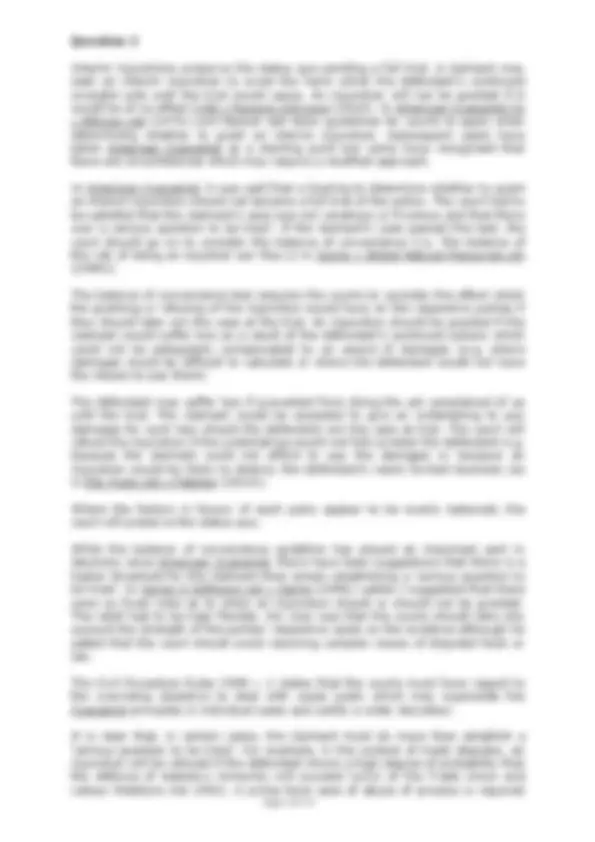
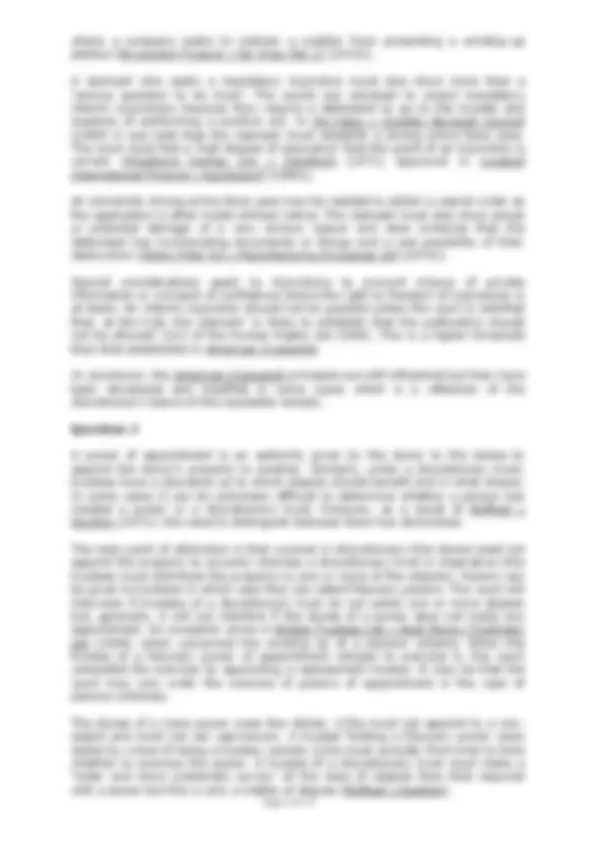
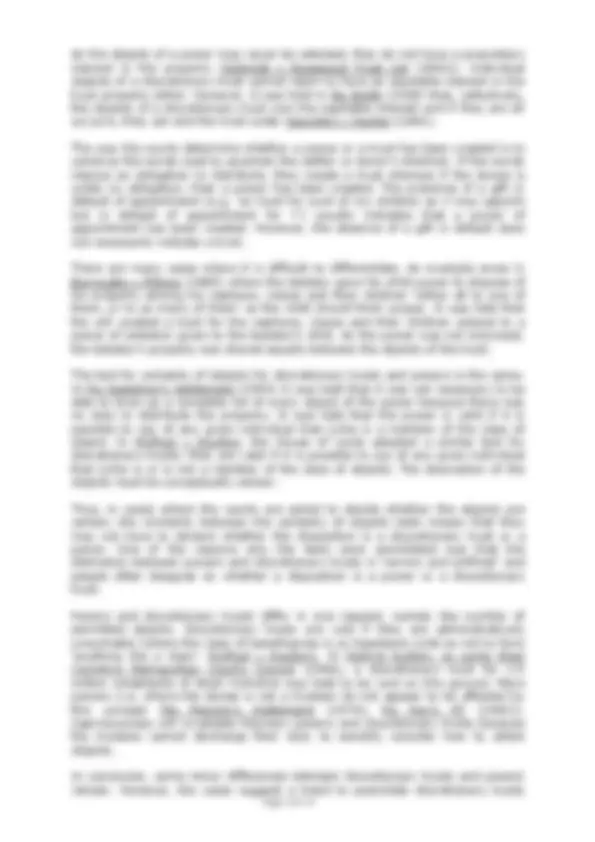
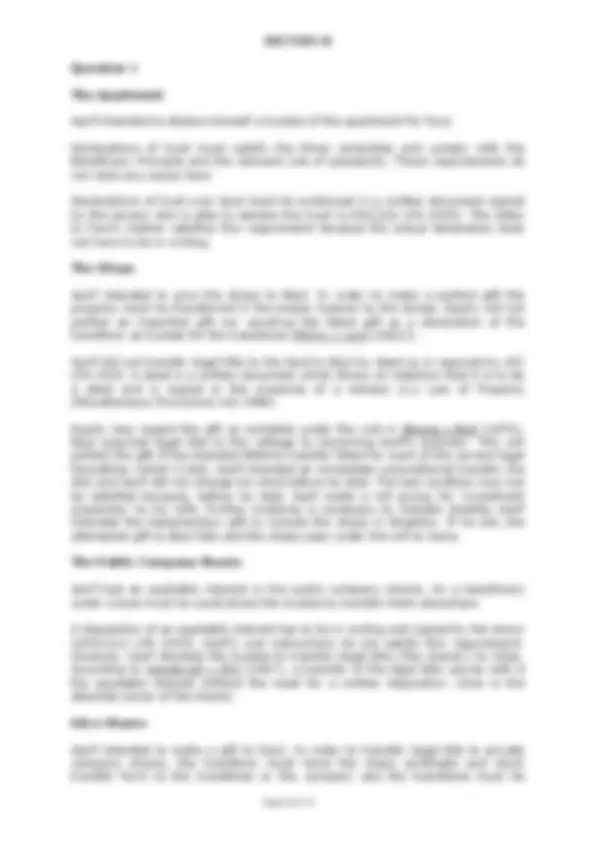
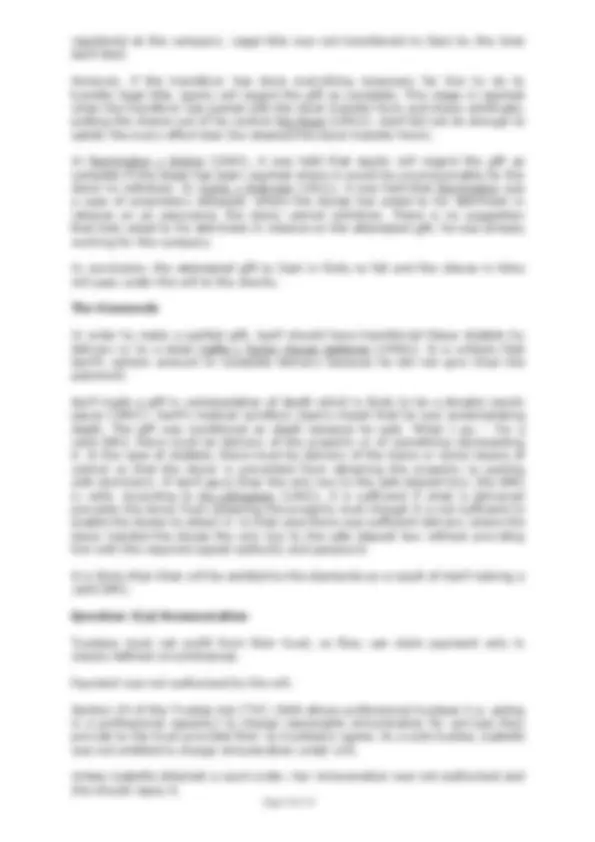
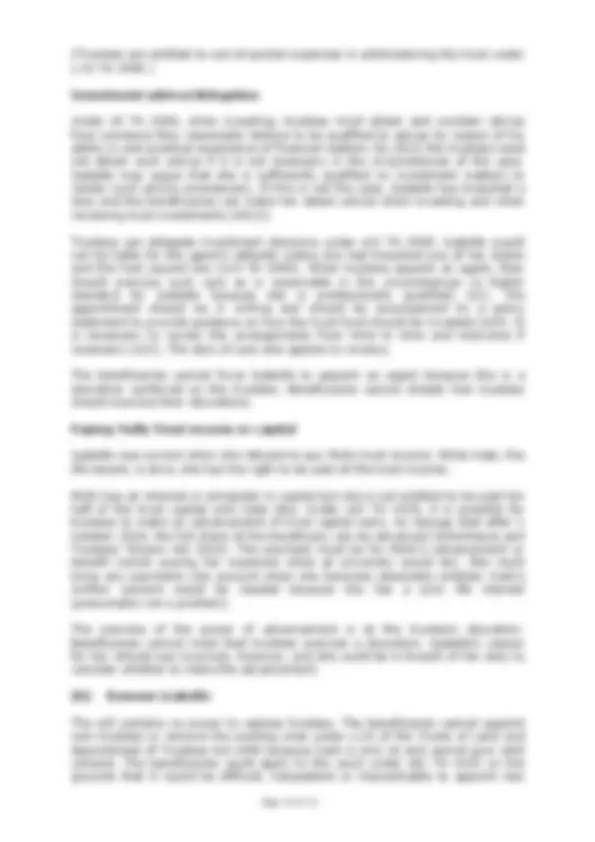
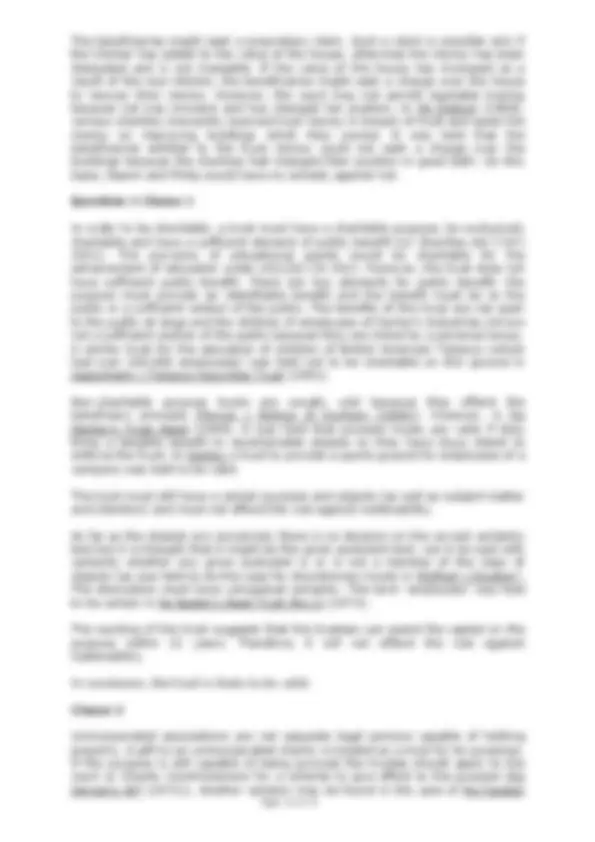
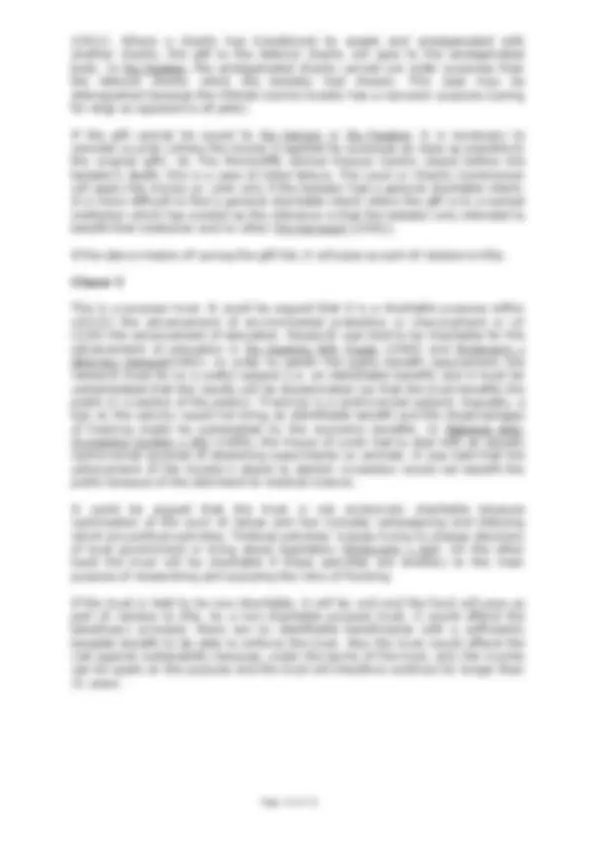


Study with the several resources on Docsity

Earn points by helping other students or get them with a premium plan


Prepare for your exams
Study with the several resources on Docsity

Earn points to download
Earn points by helping other students or get them with a premium plan
Community
Ask the community for help and clear up your study doubts
Discover the best universities in your country according to Docsity users
Free resources
Download our free guides on studying techniques, anxiety management strategies, and thesis advice from Docsity tutors
The legal concept of trusts, focusing on the certainty of intention required for their validity. It discusses the use of the word 'trust' and imposition of obligations on potential trustees as indicators of an intention to create a trust. The document also covers the existence of trusts despite the use of precatory words, the role of oral words and conduct, and the creation of trusts in commercial contexts. Additionally, it touches upon the differences between discretionary trusts and fiduciary powers, the assimilation of these two concepts, and the concept of constructive trusts.
Typology: Study notes
1 / 14

This page cannot be seen from the preview
Don't miss anything!









Note to Candidates and Tutors:
The purpose of the suggested answers is to provide students and tutors with guidance as to the key points students should have included in their answers to the June 2016 examinations. The suggested answers set out a response that a good (merit/distinction) candidate would have provided. The suggested answers do not for all questions set out all the points which students may have included in their responses to the questions. Students will have received credit, where applicable, for other points not addressed by the suggested answers.
Students and tutors should review the suggested answers in conjunction with the question papers and the Chief Examiners’ reports which provide feedback on student performance in the examination.
SECTION A Question 1
In Knight v Knight (1840), Lord Langdale stated that, to be valid, a trust required the three certainties including certainty of intention. Certainty of intention is clearly present if a settlor gives property to X ‘to hold on trust for Y’. However, it is not essential to use the word ‘trust’. Indeed, the courts seek to give effect to the substance of what the parties intend rather than insisting on the use of particular words. Furthermore, unless the property is land or an equitable interest, it is not necessary for a trust to be created in writing.
Rather than insisting on a particular formula to create a trust, the courts construe the words used to find out if that is what the settlor intended. It has been held that words imposing an obligation on the potential trustee indicate an intention to create a trust. Words such as ‘to hold for’ or ‘to distribute to’ suggest an obligation and are sufficient to indicate an intention to create a trust. Precatory words expressing a wish or hope are not sufficient on their own to indicate a trust intention. In Lambe v Eames (1871) property given to the deceased’s widow ‘to be at her disposal in any way she may think best’ were not sufficiently mandatory to create a trust. No trust was held to exist in Re Hamilton (1895) ‘I wish…’, nor in Re Adams and the Kensington Vestry (1884) ‘in full confidence that she will do what is right as to the disposal thereof between my children…’. However, the court will look at the whole document containing the disposition in question in order to ascertain the maker’s intention. Trusts were held to exist in Comiskey v Bowring-Hanbury (1905) and Re Harding (Deceased) (2007) despite the use of precatory words due to the construction of the document as a whole. Where a testator uses words from an earlier case as a precedent for creating a trust, then a trust will be held to exist despite a change in judicial attitudes since the earlier case (Re Steele’s WT (1948)).
Where the disposition is contained in a document, the court will ascertain the objective meaning of the words used. It will not allow the subjective intention of
the parties to prevail, which conflicts with the maxim. In Shah v Shah (2010) in a letter to his brother the appellant said ‘I am as from today holding 4, shares in the above company for you’. It was held that he had created a trust despite his evidence that he had intended a gift. The court reached this conclusion as a result of an objective interpretation of the words he used in the letter. In Webb v Oldfield (2011), the court adopted the same approach and decided that it had to interpret the words used in a will; the evidence that the testator held a contrary intention could not override the will. Where a document does not carry out the maker’s intention, it is possible to apply to the court for rectification.
The courts aim to carry out the parties’ intentions. It is not necessary that the settlor knows (s)he has created a trust; the court will hold that there is a trust if that is the effect of what (s)he has done.
The courts have found an intention to create a trust from oral words and conduct. It is not necessary for the settlor to use the word ‘trust’ or even to appreciate that (s)he is creating a trust; if the words or conduct suggest an imperative obligation, then it is a trust. In Rowe v Prance (1999) the claimant successfully argued that the defendant held a yacht on trust for both of them. The defendant had referred to the vessel as ‘our yacht’ and had reassured her that the yacht was her ‘security’. In Paul v Constance (1977) words such as ‘the money is as much yours as mine’ were held to create a trust. These decisions demonstrate that the courts are looking to the substance of the case rather than the form. In both cases it may have been relevant that the alleged settlor had no legal knowledge. No trust was held to exist in Margulies v Margulies (2000) where it was observed that the alleged settlor was used to instructing solicitors and, would probably have sought legal assistance had he wanted his son to benefit. It is arguable that the court went too far in Paul v Constance because there was no suggestion that Mr Paul intended to take on the role of a trustee; rather he intended a gift of a half share of the bank account.
In a commercial context, the court looked at the substance of what the parties intended in Re Kayford Ltd (in Liquidation) (1975) a trust was held to have been created where the directors of a mail order company placed customers’ money in a separate bank account. The word ‘trust’ did not appear in the title of the account and the directors did not execute a formal document creating a trust. However, they intended to protect the customers’ money from the claims of creditors and the judge decided that the effect of what they had done was to create a trust.
There are limits however. An attempt to create a trust informally will be void if the terms are uncertain (Re Challoner Club Ltd (in Liquidation) (1997); Pappadakis v Pappadakis (2000) where no trustees had been identified).
The lack of uniformity in the different words and actions which have been held to create trusts informally creates some uncertainty. However the courts’ efforts to look at the parties’ intentions rather than insisting on a particular form of words is consistent with the flexibility of equity.
where a company seeks to restrain a creditor from presenting a winding-up petition (Bryanston Finance v De Vries (No 2) (1976)).
A claimant who seeks a mandatory injunction must also show more than a ‘serious question to be tried’. The courts are reluctant to award mandatory interim injunctions because they require a defendant to go to the trouble and expense of performing a positive act. In De Falco v Crawley Borough Council (1980) it was held that the claimant must establish a strong prima facie case. The court must feel a ‘high degree of assurance’ that the grant of an injunction is correct (Shepherd Homes Ltd v Sandham (1971) approved in Locabail International Finance v Agroexport (1986)).
An extremely strong prima facie case may be needed to obtain a search order as the application is often made without notice. The claimant must also show actual or potential damage of a very serious nature and clear evidence that the defendant has incriminating documents or things and a real possibility of their destruction (Anton Piller KG v Manufacturing Processes Ltd (1976)).
Special considerations apply to injunctions to prevent misuse of private information or a breach of confidence where the right to freedom of expression is at stake. An interim injunction should not be granted unless the court is satisfied that, at the trial, the claimant ‘is likely to establish that the publication should not be allowed’ (s12 of the Human Rights Act 1998). This is a higher threshold than that established in American Cyanamid.
In conclusion, the American Cyanamid principles are still influential but they have been developed and modified in some cases which is a reflection of the discretionary nature of this equitable remedy.
Question 3
A power of appointment is an authority given by the donor to the donee to appoint the donor’s property to another. Similarly, under a discretionary trust, trustees have a discretion as to which objects should benefit and in what shares. In some cases it can be extremely difficult to determine whether a person has created a power or a discretionary trust. However, as a result of McPhail v Doulton (1971), the need to distinguish between them has diminished.
The main point of distinction is that a power is discretionary (the donee need not appoint the property to anyone) whereas a discretionary trust is imperative (the trustees must distribute the property to one or more of the objects). Powers can be given to trustees in which case they are called fiduciary powers. The court will intervene if trustees of a discretionary trust do not select one or more objects but, generally, it will not interfere if the donee of a power does not make any appointment. An exception arose in Bridge Trustees Ltd v Noel Penny (Turbines) Ltd (2008) which concerned the winding up of a pension scheme. When the trustee of a fiduciary power of appointment refused to exercise it, the court compelled the exercise by appointing a replacement trustee. It may be that the court may only order the exercise of powers of appointment in the case of pension schemes.
The donee of a mere power owes few duties; (s)he must not appoint to a non- object and must not act capriciously. A trustee holding a fiduciary power owes duties by virtue of being a trustee, namely (s)he must consider from time to time whether to exercise the power. A trustee of a discretionary trust must make a ‘wider and more systematic survey’ of the class of objects than that required with a power but this is only a matter of degree (McPhail v Doulton).
As the objects of a power may never be selected, they do not have a proprietary interest in the property (Schmidt v Rosewood Trust Ltd (2003)). Individual objects of a discretionary trust cannot claim to have an equitable interest in the trust property either. However, it was held in Re Smith (1928) that, collectively, the objects of a discretionary trust own the equitable interest and if they are all sui juris, they can end the trust under Saunders v Vautier (1841).
The way the courts determine whether a power or a trust has been created is to construe the words used to ascertain the settlor or donor’s intention. If the words impose an obligation to distribute, they create a trust whereas if the donee is under no obligation, then a power has been created. The presence of a gift in default of appointment (e.g. ‘on trust for such of my children as X may appoint but in default of appointment for Y’) usually indicates that a power of appointment has been created. However, the absence of a gift in default does not necessarily indicate a trust.
There are many cases where it is difficult to differentiate. An example arose in Burroughs v Philcox (1840) where the testator gave his child power to dispose of his property among his nephews, nieces and their children ‘either all to one of them, or to as many of them’ as the child should think proper. It was held that the will created a trust for the nephews, nieces and their children subject to a power of selection given to the testator’s child. As the power was not exercised, the testator’s property was shared equally between the objects of the trust.
The test for certainty of objects for discretionary trusts and powers is the same. In Re Gestetner’s Settlement (1953) it was held that it was not necessary to be able to draw up a complete list of every object of the power because there was no duty to distribute the property. It was held that the power is valid if it is possible to say of any given individual that (s)he is a member of the class of object. In McPhail v Doulton, the House of Lords adopted a similar test for discretionary trusts; they are valid if it is possible to say of any given individual that (s)he is or is not a member of the class of objects. The description of the objects must be conceptually certain.
Thus, in cases where the courts are asked to decide whether the objects are certain, the similarity between the certainty of objects tests means that they may not have to declare whether the disposition is a discretionary trust or a power. One of the reasons why the tests were assimilated was that the distinction between powers and discretionary trusts is ‘narrow and artificial’ and people often disagree on whether a disposition is a power or a discretionary trust.
Powers and discretionary trusts differ in one respect; namely the number of permitted objects. Discretionary trusts are void if they are administratively unworkable (where the class of beneficiaries is so hopelessly wide as not to form ‘anything like a class’: McPhail v Doulton). In District Auditor, ex parte West Yorkshire Metropolitan County Council (1986), a discretionary trust for 2. million inhabitants of West Yorkshire was held to be void on this ground. Mere powers (i.e. where the donee is not a trustee) do not appear to be affected by this concept (Re Manisty’s Settlement (1974); Re Hay’s ST (1982)). Capriciousness will invalidate fiduciary powers and discretionary trusts because the trustees cannot discharge their duty to sensibly consider how to select objects.
In conclusion, some minor differences between discretionary trusts and powers remain. However, the cases suggest a trend to assimilate discretionary trusts
is no express agreement, the court would infer the parties’ intentions regarding the size of their respective shares in the property from the whole course of dealings. Baroness Hale envisaged that many factors could be taken into account including advice or discussions at the time of the purchase, the purpose for which the house was acquired, the nature of the parties’ relationship, whether they had children for whom they both had responsibility to provide a home, how the purchase was financed, how the parties arranged their finances, both initially and subsequently, how they discharged outgoings and household expenses, the fact that one party has brought about a substantial improvement to the property.
In Jones v Kernott (2009) the Supreme Court held that if there was no express agreement as to the shares, the court would infer the parties’ intentions according to what would be fair having regard to the whole course of dealings. The Supreme Court also recognised that the parties’ intentions as to their shares could change over time.
4(b)
In Stack v Dowden, Baroness Hale observed that constructive trusts are a more suitable means of determining disputes between cohabitees than resulting trusts because constructive trusts take account of a wider range of contributions.
However, constructive trusts were not developed specifically to deal with disputes between cohabitees and many would argue that they are not suitable for this purpose.
An express common intention is difficult to prove (given that the parties are recalling oral conversations which took place several years earlier) and many do not discuss ownership of the equitable interest. The process of inferring a common intention is artificial.
A claimant who has not contributed financially but has looked after the home and/or family will not be able to establish an interest under a constructive trust in the absence of an express common intention. Even where the claimant has made direct financial contributions, he or she must gather evidence from a paper trail of bank statements etc. which is an expensive exercise and can be impossible due to the passage of time.
In its report ‘Cohabitaton: The Financial Consequences of Relationship Breakdown’ the Law Commission recommended legislation. The claimant would have to show that the defendant had retained a benefit or the claimant had a continuing economic disadvantage as a result of contributions made to the relationship. Claimants who had made non-financial contributions would have redress. The court could grant appropriate financial relief such as a lump sum or an interest in the property.
Currently, the outcome of a claim might well depend on fortuitous factors such as whether ownership of the home was discussed at the outset. A statutory scheme which pays more attention to social considerations and places less emphasis on financial contributions is likely to be more effective.
Question 1
The Apartment
Aarif intended to declare himself a trustee of the apartment for Fara.
Declarations of trust must satisfy the three certainties and comply with the Beneficiary Principle and the relevant rule of perpetuity. These requirements do not raise any issues here.
Declarations of trust over land must be evidenced in a written document signed by the person who is able to declare the trust (s.53(1)(b) LPA 1925). The letter to Fara’s mother satisfies this requirement because the actual declaration does not have to be in writing.
The Shops
Aarif intended to give the shops to Bijul. In order to make a perfect gift the property must be transferred in the proper manner to the donee. Equity will not perfect an imperfect gift nor construe the failed gift as a declaration of the transferor as trustee for the transferee (Milroy v Lord (1862)).
Aarif did not transfer legal title to the land to Bijul by deed as is required by s LPA 1925. A deed is a written document which shows an intention that it is to be a deed and is signed in the presence of a witness (s.1 Law of Property (Miscellaneous Provisions) Act 1989).
Equity may regard the gift as complete under the rule in Strong v Bird (1874). Bijul acquired legal title to the cottage by becoming Aarif’s executor. This will perfect the gift if the intended lifetime transfer failed for want of the correct legal formalities (which it did), Aarif intended an immediate unconditional transfer (he did) and Aarif did not change his mind before he died. The last condition may not be satisfied because, before he died, Aarif made a will giving his ‘investment properties’ to his wife. Further evidence is necessary to indicate whether Aarif intended the testamentary gift to include the shops in Brighton. If he did, the attempted gift to Bijul fails and the shops pass under the will to Hana.
The Public Company Shares
Aarif had an equitable interest in the public company shares. As a beneficiary under a bare trust he could direct the trustee to transfer them elsewhere.
A disposition of an equitable interest has to be in writing and signed by the donor (s53(1)(c) LPA 1925). Aarif’s oral instructions do not satisfy this requirement. However, Aarif directed the trustee to transfer legal title (‘the shares’) to Chan. According to Vandervell v IRC (1967), a transfer of the legal title carries with it the equitable interest without the need for a written disposition. Chan is the absolute owner of the shares.
Edco Shares
Aarif intended to make a gift to Dani. In order to transfer legal title to private company shares, the transferor must hand the share certificate and stock transfer form to the transferee or the company and the transferee must be
(Trustees are entitled to out-of-pocket expenses in administering the trust under s.31 TA 2000.)
Investment advice/delegation
Under s5 TA 2000, when investing, trustees must obtain and consider advice from someone they reasonably believe to be qualified to advise by reason of his ability in and practical experience of financial matters. By s5(3) the trustees need not obtain such advice if it is not necessary in the circumstances of the case. Isabelle may argue that she is sufficiently qualified on investment matters to render such advice unnecessary. If this is not the case, Isabelle has breached a duty and the beneficiaries can make her obtain advice when investing and when reviewing trust investments (s5(2)).
Trustees can delegate investment decisions under s11 TA 2000. Isabelle would not be liable for the agent’s defaults unless she had breached one of her duties and this had caused loss (s23 TA 2000). When trustees appoint an agent, they should exercise such care as is reasonable in the circumstances (a higher standard for Isabelle because she is professionally qualified) (s1). The appointment should be in writing and should be accompanied by a policy statement to provide guidance on how the trust fund should be invested (s15). It is necessary to review the arrangements from time to time and intervene if necessary (s22). The duty of care also applies to reviews.
The beneficiaries cannot force Isabelle to appoint an agent because this is a discretion conferred on the trustees. Beneficiaries cannot dictate how trustees should exercise their discretions.
Paying Molly Trust income or capital
Isabelle was correct when she refused to pay Molly trust income. While Kate, the life tenant, is alive, she has the right to be paid all the trust income.
Molly has an interest in remainder in capital but she is not entitled to be paid her half of the trust capital until Kate dies. Under s32 TA 1925, it is possible for trustees to make an advancement of trust capital early. As George died after 1 October 2014, the full share of the beneficiary can be advanced (Inheritance and Trustees’ Powers Act 2014). The payment must be for Molly’s advancement or benefit (which paying her expenses while at university would be). She must bring any payments into account when she becomes absolutely entitled. Kate’s written consent would be needed because she has a prior life interest (presumably not a problem).
The exercise of the power of advancement is at the trustee’s discretion. Beneficiaries cannot insist that trustees exercise a discretion. Isabelle’s reason for her refusal was incorrect, however, and she could be in breach of her duty to consider whether to make the advancement.
(b) Remove Isabelle
The will contains no power to replace trustees. The beneficiaries cannot appoint new trustees or remove the existing ones under s.19 of the Trusts of Land and Appointment of Trustees Act 1996 because Zach is only 16 and cannot give valid consent. The beneficiaries could apply to the court under s41 TA 1925 on the grounds that it would be difficult, inexpedient or impracticable to appoint new
trustees without the court’s intervention and that it would be expedient for the court to act. If the court were to intervene, Isabelle would have to be replaced.
(c) Ending the trust
Under Saunders v Vautier (1841) if all the beneficiaries are sui juris and between them absolutely entitled, they can agree to end the trust and call on the trustee to transfer the trust property to them in such shares as they agree. However, such an arrangement is not possible here because Zach is under 18.
The beneficiaries could apply for the court to consent to a variation or revocation of the trust on Zach’s behalf under s1(1) (a) Variation of Trusts Act 1958. Kate and Molly must agree to the variation (Re Suffert (1960)).The court will not consent unless the variation is for Zach’s ‘benefit’. He will receive a smaller share (one-third as opposed to one-half) but he will receive it earlier. He will not have to wait until Kate dies. The courts do not approve of young beneficiaries receiving money too early (Re T’s ST (1964)) but contrast Wright v Gater (2011). The beneficiaries might suggest a trust for Zach until he is say, 21. In Ridgwell v Ridgwell (2007) the court approved a scheme where the beneficiary’s entitlement was delayed in terms of age but this disadvantage was offset by a prior life interest being surrendered. A further benefit lay in the tax savings the trust would make.
The settlor’s intention is not an overriding factor (Goulding v James (1997)).
Question 3 Tom
Tom is clearly in breach of trust. However, the beneficiaries would be ill-advised to bring a personal claim against him because they would join the queue of ordinary unsecured creditors on his bankruptcy and would be unlikely to recover much money. A proprietary claim is preferable because it would have priority over Tom’s creditors.
The beneficiaries can use equitable tracing because they have an equitable proprietary interest in the trust property. It is advantageous to use equitable tracing because it is effective when the trust fund has been mixed with the trustee’s money.
Tom has mixed £10,000 of trust money with £20,000 of his own money and has used the combined sum to buy a car. The beneficiaries are entitled to a charge over the car for £10,000 (Re Hallett’s Estate (1880); Foskett v McKeown (2000)). They can insist that the car is sold and recover their £10,000 from the proceeds.
In May, Tom mixed £30,000 of trust money with £10,000 of his own money in a current account from which withdrawals were made. It is necessary to establish whose money was dissipated on repaying debts and whose money was used to buy the shares.
In Re Hallett’s Estate, it was established that a trustee is deemed to spend his own money first. This would mean that Tom’s money (with only £10,000 of trust money) was used to buy the shares and the remaining £20,000 of trust money was dissipated on the debts and cannot be traced. The beneficiaries could claim a charge over the shares and, according to obiter comments in Re Tilley’s WT (1967), they would recover a proportion of the increase in value. By this route, the beneficiaries would recover £12,500 which is not the best outcome.
The beneficiaries might seek a proprietary claim. Such a claim is possible only if the kitchen has added to the value of the house; otherwise the money has been dissipated and is not traceable. If the value of the house has increased as a result of the new kitchen, the beneficiaries might seek a charge over the house to recover their money. However, the court may not permit equitable tracing because Val was innocent and has changed her position. In Re Diplock (1948), various charities innocently received trust money in breach of trust and spent the money on improving buildings which they owned. It was held that the beneficiaries entitled to the trust money could not seek a charge over the buildings because the charities had changed their position in good faith. On this basis, Naomi and Philip would have no remedy against Val.
Question 4 Clause 1
In order to be charitable, a trust must have a charitable purpose, be exclusively charitable and have a sufficient element of public benefit (s2 Charities Act (‘CA’) 2011). The provision of educational grants would be charitable for the advancement of education under s3(1)(b) CA 2011. However, the trust does not have sufficient public benefit. There are two elements for public benefit: the purpose must provide an identifiable benefit and the benefit must be to the public or a sufficient section of the public. The benefits of this trust are not open to the public at large and the children of employees of Harker’s Industries Ltd are not a sufficient section of the public because they are linked by a personal nexus. A similar trust for the education of children of British American Tobacco (which had over 100,000 employees) was held not to be charitable on this ground in Oppenheim v Tobacco Securities Trust (1951).
Non-charitable purpose trusts are usually void because they offend the beneficiary principle (Morice v Bishop of Durham (1804)). However, in Re Denley’s Trust Deed (1969), it was held that purpose trusts are valid if they bring a tangible benefit to ascertainable objects so they have locus standi to enforce the trust. In Denley a trust to provide a sports ground for employees of a company was held to be valid.
The trust must still have a certain purpose and objects (as well as subject matter and intention) and must not offend the rule against inalienability.
As far as the objects are concerned, there is no decision on the correct certainty test but it is thought that it might be the given postulant test: can it be said with certainty whether any given postulant is or is not a member of the class of objects (as was held to be the case for discretionary trusts in McPhail v Doulton). The description must have conceptual certainty. The term ‘employees’ was held to be certain in Re Baden’s Deed Trust (No 2) (1973).
The wording of the trust suggests that the trustees can spend the capital on the purpose within 21 years. Therefore, it will not offend the rule against inalienability.
In conclusion, the trust is likely to be valid.
Clause 2
Unincorporated associations are not separate legal persons capable of holding property. A gift to an unincorporated charity is treated as a trust for its purposes. If the purpose is still capable of being pursued the trustee should apply to the court or Charity Commissioners for a scheme to give effect to the purpose (Re Vernon’s WT (1971)). Another solution may be found in the case of Re Faraker
(1912). Where a charity has transferred its assets and amalgamated with another charity, the gift to the defunct charity will pass to the amalgamated body. In Re Faraker, the amalgamated charity carried out wider purposes than the defunct charity which the testator had chosen. This case may be distinguished because the Hillside Canine Society has a narrower purpose (caring for dogs as opposed to all pets).
If the gift cannot be saved by Re Vernon or Re Faraker, it is necessary to consider cy-près (where the money is applied for purposes as close as possible to the original gift). As The Minchcliffe Animal Rescue Centre closed before the testator’s death, this is a case of initial failure. The court or Charity Commission will apply the money cy- près only if the testator had a general charitable intent. It is more difficult to find a general charitable intent where the gift is to a named institution which has existed as the inference is that the testator only intended to benefit that institution and no other (Re Harwood (1936)).
If the above means of saving the gift fail, it will pass as part of residue to Ella.
Clause 3
This is a purpose trust. It could be argued that it is a charitable purpose within s3(1)(i) the advancement of environmental protection or improvement or s (1)(b) the advancement of education. Research was held to be charitable for the advancement of education in Re Hopkins Will Trusts (1965) and McGovern v Attorney General(1982). In order to satisfy the public benefit requirement, the research must be on a useful subject (i.e. an identifiable benefit) and it must be contemplated that the results will be disseminated (so that the trust benefits the public or a section of the public). ‘Fracking’ is a controversial subject. Arguably, a ban on the activity would not bring an identifiable benefit and the disadvantages of fracking might be outweighed by the economic benefits. In National Anti- Vivisection Society v IRC (1948), the House of Lords had to deal with an equally controversial purpose of abolishing experiments on animals. It was held that the achievement of the Society’s object to abolish vivisection would not benefit the public because of the detriment to medical science.
It could be argued that the trust is not exclusively charitable because continuation of the work of James and Ken includes campaigning and lobbying which are political activities. ‘Political activities’ include trying to change decisions of local government or bring about legislation (McGovern v AG). On the other hand the trust will be charitable if these activities are ancillary to the main purpose of researching and exposing the risks of fracking.
If the trust is held to be non-charitable, it will be void and the fund will pass as part of residue to Ella. As a non-charitable purpose trust, it would offend the beneficiary principle; there are no identifiable beneficiaries with a sufficiently tangible benefit to be able to enforce the trust. Also the trust would offend the rule against inalienability because, under the terms of the trust, only the income can be spent on the purpose and the trust will therefore continue for longer than 21 years.